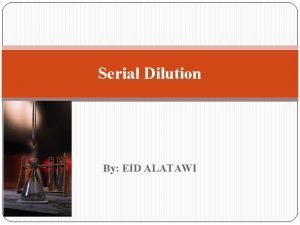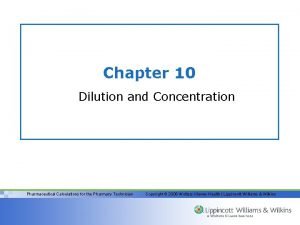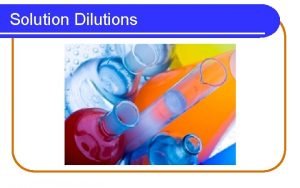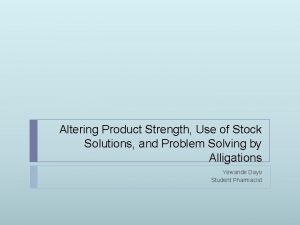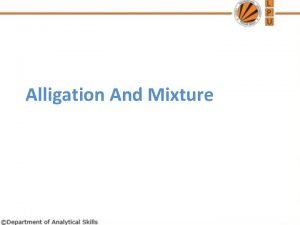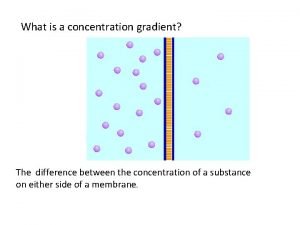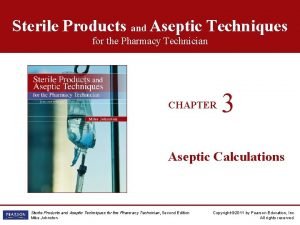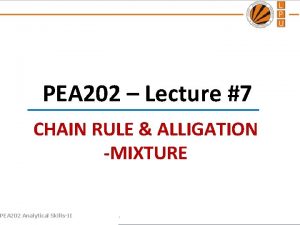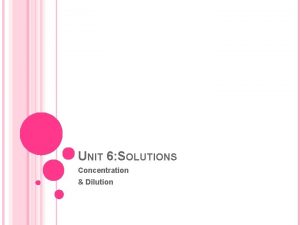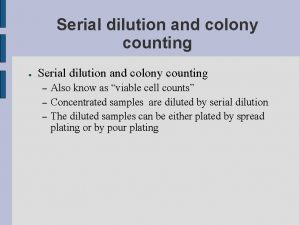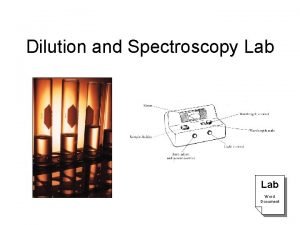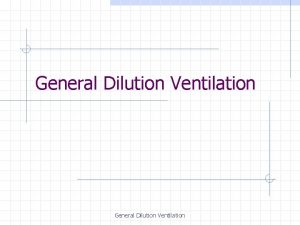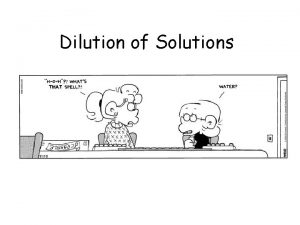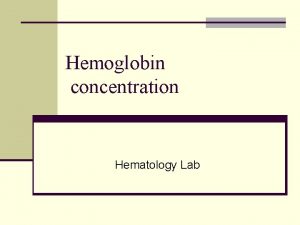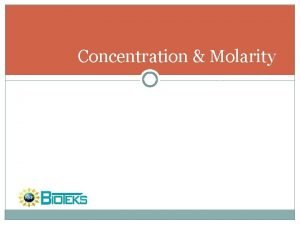Dilution Concentration and Alligation Jan 2018 Dilution Concentration











- Slides: 11

Dilution, Concentration and Alligation Jan -2018

Dilution, Concentration and Alligation • There are occasions in which the dilution or concentration of a pharmaceutical preparation is either desirable or required. • 1 st quantity X 1 st concentration = 2 nd quantity X 2 nd concentration • Q 1 X C 1 = Q 2 X C 2 • Example(1): if 500 ml of 15% v/v solution are diluted to 1500 ml, what will be the percentage strength (v/v) • Q 1 X C 1 = Q 2 X C 2 • 500(ml) X 15(%) = 1500(ml) X x(%) • Example(2): if 50 ml of 1: 20 w/v solution are diluted to 1000 ml, what is the ratio strength (w/v)? • 1 : 20 = 5% • • X = 5% Q 1 X C 1 = Q 2 X C 2 50(ml) X 5(%) = 1000(ml) X x(%) Dr. Osama A. A. Ahmed X = 0. 25% = 1: 400 2

• Stock solutions: are concentrated solutions of active (e. g. drug) or inactive (e. g. colorant) substances and are used by pharmacists as a convenience to prepare solutions of lesser concentrations. • Example(1): How many milliliters of a 1: 400 w/v stock solution should be used to make 4 liters of a 1 : 2000 w/v solution? • 1: 400 = 0. 25% and 1: 2000 = 0. 05% and 4 liters = 4000 ml • Q 1 X C 1 = Q 2 X C 2 • 4000(ml) X 0. 05(%) = X (ml) X 0. 25(%) X = 800 ml • Example(2): How many milliliters of a 1: 50 stock solution of phenylephrine hydrochloride should be used in compounding the following prescription. • R/ phenylephrine HCl 0. 25% • Rose water ad 30 ml • Sig. For the nose • 1 : 50 = 2 % • x X 2% = 30 X 0. 25% X = 3. 75 ml

• Some calculations used in pharmacy in which the strength of a diluted portion of a solution is defined, but the strength of the concentrated stock solution used to prepare it must be determined. • e. g. when the pharmacist need to prepare and dispense a concentrated solution and direct the patient to use small volume (5 ml, teaspoonful) and dilute it in a specified volume of water. • Example(1): How much drug should be used in preparing 50 ml of a solution such that 5 ml diluted to 500 ml will yield a 1: 1000 solution? • 1 : 1000 solution 0. 5 g : 500 ml • 0. 5 g drug in 500 ml is the same amount found in 5 ml • 0. 5 • X 5 50 X=5 g • Example(2): How many milliliters of water should be added to 300 ml of a 1: 750 w/v solution of benzalkonium chloride to make a 1: 2500 w/v solution? (Page 242) • 1 750 • X 300 • 1 2500 • 0. 4 X X = 0. 4 g X = 1000 ml 1000 – 300 = 700 ml

• Dilution of alcohol: when water and alcohol are mixed there is a physical contraction in the resultant volume. • Example: How much water should be mixed with 5000 ml 85% v/v alcohol to make 50% v/v alcohol? • Q 1 X C 1 = Q 2 X C 2 5000(ml) X 85(%) = X (ml) X 50(%) X = 8500 ml so enough water is added to make 8500 ml. • Dilution of acids: the strength of concentrated acids (official) are expressed as % w/w, while diluted acids are expressed as w/v. Consider the specific gravity of conc. Acids in calculations • Example: How many mls of 37% w/w HCl having a specific gravity of 1. 20 are required to make 1000 ml of dil HCl 10% w/v? • 1000 X 0. 1 = 100 gm of HCl 100% in 1000 ml of 10% w/v • Q 1 X C 1 = Q 2 X C 2 100 g X 100(%) = X (ml) X 37(%) X = 270 g of 37% acid 270/1. 2 = 225 ml

• Dilution and concentration of solids and semisolids: • Example: How many grams of opium containing 15 w/w of morphine and how many grams of lactose should be used to prepare 150 g of opium containing 10% w/w of morphine? • Q 1 X C 1 = Q 2 X C 2 X g X 15(%) = 150 g X 10(%) X = 100 g of 15% opium 150 g - 100 g = 50 g of lactose • Example: How many grams of 20% benzocaine ointment and how many grams of ointment base (diluent) should be used in preparing 5 lb. of 2. 5 % benzocaine ointment? • 5 lb = 454 g X 5 = 2270 g • Q 1 X C 1 = Q 2 X C 2 2270 g X 2. 5(%) = X g X 20(%) X = 283. 75 or 284 g 2270 – 284 = 1986 g of ointment base

• • Alligation Arithmatical method of solving problems that involves the mixing of solutions or mixtures of solids possessing different percentage strengths. • • Alligation medial A method by which the weighted average percentage strength of a mixture of two or more substances of known quantity and concentration may be easily calculated. • Example: what is the percentage (v/v) of alcohol in a mixture of 300 ml 40% (v/v) alcohol and 100 ml 60% (v/v) alcohol ? Q 1 C 1 + Q 2 C 2 + Q 3 C 3 +……. . = Qt. Ct Qt = 300+100 = 400 ml 300 X 40 + 100 X 60 = 400 X Ct Ct = 18000/400 = 45 %

• • • Alligation alternate A method by which we may calculate the number of parts of two or more components of a given strength when they are mixed to prepare a mixture of desired strength. A final proportion permits us to translate relative parts to any specific denomination. • Example: in what proportion should alcohol 95% and 55% strengths be mixed to make 70% alcohol? • Available strength • 95% mi n • • 55% us f ro m desired strength e giv number of parts 15 parts (95%) s 70% giv es 25 parts ( 55%)



 Alligation medial and alligation alternate
Alligation medial and alligation alternate 1/3 serial dilution
1/3 serial dilution 1/2 dilution
1/2 dilution Pharmacy dilution formula
Pharmacy dilution formula Dilution formula
Dilution formula Alligation calculator creams and ointments
Alligation calculator creams and ointments Alligation of mixture problems
Alligation of mixture problems Alligation calculator creams and ointments
Alligation calculator creams and ointments Concentration gradient vs concentration difference
Concentration gradient vs concentration difference Movement of high concentration to low concentration
Movement of high concentration to low concentration Alligation pharmacy
Alligation pharmacy Alligation rule
Alligation rule

